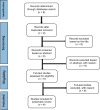Effect of constraint-induced movement therapy combined with neuromuscular electrical stimulation on upper extremity function in stroke survivors: A protocol for systematic review
- PMID: 37443502
- PMCID: PMC10344548
- DOI: 10.1097/MD.0000000000034249
Effect of constraint-induced movement therapy combined with neuromuscular electrical stimulation on upper extremity function in stroke survivors: A protocol for systematic review
Abstract
Background: Motor impairment is common after a stroke and directly affects the function and quality of life of stroke survivors. Constraint-induced movement therapy and neuromuscular electrical stimulation are interventions that facilitate functional recovery of the upper extremities of a particular subgroup of stroke survivors. The objective of this study was to summarize the available evidence on the effects of neuromuscular electrical stimulation combined with constraint-induced movement therapy in patients with stroke.
Methods: We conducted a comprehensive search of published articles in electronic databases, including PubMed, Scopus, PEDro, Medline (via Ovid), EMBASE, Cochrane Library, and Web of Science, using the following search terms: "stroke"; "upper extremity"; "Constraint-Induced Movement Therapy"; and "Neuromuscular Electrical Stimulation." The search included published studies, conferences, and presentations. The article selection, data extraction, and quality evaluation will be conducted independently by 2 reviewers. The 3rd and 4th reviewers will assist in resolving any disagreements that may arise between the 2 reviewers. The risk of bias in the included studies will be assessed using the PEDro scale and Cochrane risk of bias assessment tool. Narrative synthesis and meta-analysis will be performed based on the characteristics of the included articles, including the risk of bias (if sufficient information is available).
Results: This review summarizes the available evidence and could assist therapists in choosing the best treatment for poststroke upper extremity dysfunction.
Conclusion: This study will provide the available evidence on the effectiveness of CIMT and NMES on upper extremity function in patients with stroke.
Ethics and dissemination: Ethical approval is not required because the review will be based on publicly available literature. The findings of this study will be published in a peer-reviewed journal, and updates will be made depending on whether sufficient additional evidence modifies the conclusions of the review. Any changes made to the methods throughout the review will be stated in the article.
Systematic review registration: PROSPERO CRD42023415645.
Copyright © 2023 the Author(s). Published by Wolters Kluwer Health, Inc.
Conflict of interest statement
The authors have no conflicts of interest to disclose.
Figures
Similar articles
-
Telerehabilitation for lower extremity recovery poststroke: a systematic review and meta-analysis protocol.BMJ Open. 2022 Mar 9;12(3):e055527. doi: 10.1136/bmjopen-2021-055527. BMJ Open. 2022. PMID: 35264359 Free PMC article.
-
Effectiveness of virtual reality-based rehabilitation on the upper extremity motor function of stroke patients: A protocol for systematic review and meta-analysis.PLoS One. 2024 Nov 7;19(11):e0313296. doi: 10.1371/journal.pone.0313296. eCollection 2024. PLoS One. 2024. PMID: 39509415 Free PMC article.
-
Theta burst stimulation for upper limb motor dysfunction in patients with stroke: A protocol of systematic review and meta-analysis.Medicine (Baltimore). 2019 Nov;98(46):e17929. doi: 10.1097/MD.0000000000017929. Medicine (Baltimore). 2019. PMID: 31725646 Free PMC article.
-
Neuromuscular Electrical Stimulation Improves Activities of Daily Living Post Stroke: A Systematic Review and Meta-analysis.Arch Rehabil Res Clin Transl. 2021 Nov 12;4(1):100167. doi: 10.1016/j.arrct.2021.100167. eCollection 2022 Mar. Arch Rehabil Res Clin Transl. 2021. PMID: 35282150 Free PMC article. Review.
-
Mirror therapy simultaneously combined with electrical stimulation for upper limb motor function recovery after stroke: a systematic review and meta-analysis of randomized controlled trials.Clin Rehabil. 2021 Jan;35(1):39-50. doi: 10.1177/0269215520951935. Epub 2020 Aug 24. Clin Rehabil. 2021. PMID: 32830512
Cited by
-
A Scoping Review of Technology-Based Approaches for Upper Limb Motor Rehabilitation after Stroke: Are We Really Targeting Severe Impairment?J Clin Med. 2024 Sep 12;13(18):5414. doi: 10.3390/jcm13185414. J Clin Med. 2024. PMID: 39336901 Free PMC article.
References
MeSH terms
LinkOut - more resources
Full Text Sources
Medical


